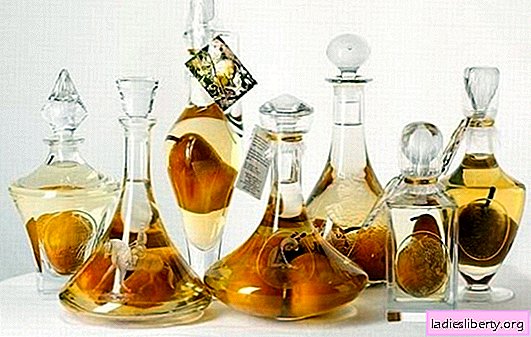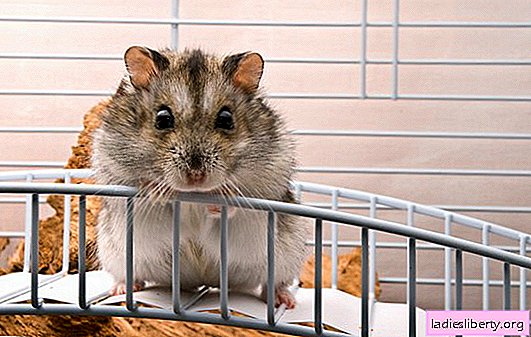
Fruit trees and berry berries delight their owners with a no less valuable crop than grapes.
Depending on the variety of pears, you can collect from 20 to 160 kg of fruit from one tree. And if 20 kg can still be processed into jams and juices, then 160 kg is a clear prerequisite for the start of pear wine making at home.
Even for those who buy berries and fruits on the market, but prefer to have their own wine in their home bar, it will not be out of place to learn about some of the subtleties of technology.
Pear wine at home - basic technological principles
The main points of wine production from fruit and berry raw materials and grapes do not have significant differences.
The stages of winemaking in both cases include:
Collection, sorting and preparation of raw materials:
The distinction of wine from pears and grapes - a traditional product for winemaking - lies only in the wine material itself.
The grapes are smaller, and there is no need to chop them. In addition, unlike pear fruits, grape fiber, which contains juice, has a less dense structure, which allows you to easily extract it by pressing, without preliminary processing.
Thousands of years of breeding experience in viticulture has allowed to bring the most valuable varieties of culture for the production of grape wines. Fruit and berry winemaking is a relatively young technology, therefore, in terms of variety variety for wine production, it is relatively not rich in choosing the right material.
For pear wine at home, the fruits of technical ripeness are suitable, that is, not overripe. They are harvested when the seeds are not yet ripe in the fruit. This is explained by the fact that it is rather difficult to get transparent juice from ripe pears, and then wine without sediment. Overripe pears during fermentation also emit methyl alcohol, which is extremely dangerous for health.
To wash or not to wash? On the one hand, wild yeast necessary for fermentation settles on the pear skin in natural conditions, and on the other, it all depends on the ecology of the area where the crop is harvested. Road dust and other pollutants will not enhance the taste of the wine if the tree grows in such conditions. Therefore, it’s better not to risk it — wash the pears, preferably under a strong stream of water. And then be sure to proceed to their immediate processing. Remove the stalks, seeds, cut off all the damage to the fruit.
Getting juice or pulp:
It is quite difficult to get juice from the pear pulp using a juicer and even a press, grinding fruits manually or chopping them through a meat grinder or processor. And the difficulty lies in the large losses of fruit material, which can be used more productively.
On average, from 1 kg of cultivated varieties of pears, you can get 600 ml of juice, from wild pear - 500 ml. 40-50% loss is a rather impressive figure, making pear wine an expensive pleasure if you prepare it using any of the available methods for squeezing juice.
There is a more economical option that is applicable to wine technology.
Since juice is necessary for making wine, that is, for further fermentation, you should not spend energy and time on any of the methods of pressing: just chop the pears, add sugar and add a small portion of water or any other juice (if you plan to make blended wine ).
That is, we immediately get the pulp, which is also a must, bypassing the process of pressing or pressing.
Fermentation, just, is the way that will allow you to get the maximum juice. As soon as the wine is ready, the thick of it will settle to the bottom of the bottle and will only need to remove the young wine from it. In this way, you can increase the yield of juice from the fruit by another 20%.
Preparation of the wort and its saturation necessary for fermentation elements:
To start the fermentation process in the prepared wort, it is necessary to start the yeast and provide them with conditions for normal operation. In particular, for pears, it is necessary to bring the wort to the desired level of acidity and sugar content.
• Acidity. The acid content in wine at the initial stage is important as a fermentation factor, and subsequently its presence forms the taste of the drink. In grapes, the average acidity is 1.1%, in apples 0.7-1.2% (depending on the variety), and in pears 0.4-0.6%.
It should be noted that in wild varieties of pears, acidity, nevertheless, reaches 1%, but in some cultivars it is completely absent, with the exception of tannic acid, which is present in fruits in negligible amounts (0.1-0.4%).
From what has been said, it is necessary to increase the acidity of pear wort artificially: by adding citric acid or by blending pear wort with fruits that have a higher acid content. Blending allows you to get new and interesting flavors, while creating the necessary environment for fermentation.
• Sugar. To obtain wine, the content of sugar and acids in the raw materials used is of great importance. In most cases, fruit wine has to be flavored with juice or pulp, due to the lack of sufficient sugar in the fruit, or, conversely, diluted with water due to their increased content. For comparison: the sugar content in industrial grape varieties reaches 24% per unit volume, in apples this indicator ranges from 6-12%, and in pears it is 5 - 10.5% per 100 ml3.
Despite the apparent sweetness, pears contain less sugar than, for example, apples, as they have a lower acid content.
• Yeast. The determining factor for fermentation is wine yeast. As for any living organism, yeast needs to:
a) Nutrition (ammonium salts).
Nitrogen stimulates yeast multiplication and an increase in the number of their colonies. This, in turn, enhances the intensity of fermentation. In addition, nitrogenous compounds ferment the future wine, creating its aroma.
b) The energy that sugar (carbohydrates) gives.
He is also involved in the formation of alcohol.
c) Oxygen.
At the beginning of fermentation, its entry into the wort, where colonies of wild or artificial yeast are already located, is necessary. It is impossible to cause fermentation without access of air, since its absence stops the reproduction of yeast. But too much oxygen in the wort can cause wine to oxidize and turn it into vinegar. Therefore, as soon as a frothy “cap” forms on the surface of the fermented wort, the container is closed with a water shutter or a rubber glove to ensure carbon dioxide escape and, at the same time, protect the wine from souring.
d) Temperature condition.
Here it is necessary to know that at temperatures below + 15 ° C the yeast becomes sluggish and fermentation is significantly slowed down. Even lower temperatures can cause it to stop completely. It should also be borne in mind that the upper temperature threshold that yeast can withstand is + 38 ° C, and at a temperature of + 50 ° C, wine yeast dies. And if in the case of supercooling of the wort the process can still be started by placing the container in normal temperature conditions, then at a critically high temperature it is impossible to correct the situation.
Cooking the sourdough.
If it turned out that there is no special wine yeast, and the process of making wine is already in full swing and you cannot put it off, then you can use the universal recipe for yeast:
1 part raisins;
3 parts sugar;
4 parts of water.
Raisins are covered with syrup so that the container is filled on ¾ of the volume. Crockery with ferment is covered with a hygroscopic cloth and is removed in a dark and warm place. This yeast can be thrown into the wort after 7-10 days along with raisins.
The norm of the finished fermented mixture for dry wine - 2% of the volume of wort for sweet, and for dessert wines - 3%.
As a material for sourdough, a jar of any jam, figs, raspberries, currants, which are prepared in a similar way, is suitable.
Fermentation:
Once all the necessary conditions are met, fermentation will begin. Further, getting wine is a matter of time. At the initial stage, fermentation will be stormy. A “cap” of small particles of fruit will rise. Then they (particles) will start to gradually sink to the bottom of the bottle, fermentation will gradually become quiet. And as soon as the release of the smallest gas bubbles stops completely, the process can be considered completed. But the wine is not ready yet.
Lightening and sedimentation:
Now you have to wait until the whole suspension settles to the bottom, and the young wine reaches transparency. Take a flexible hose or tube made of plastic or rubber, and use it to filter the wine into other dishes from the sediment at the bottom. Perhaps the withdrawal will have to be repeated if the wine is not transparent enough. Just let it stand a little longer and repeat the procedure.
Anchoring:
Before you put the wine on the shutter speed and bottling, of course, you must first taste it, and then fix it.
• One of the ways of fixing (preservation) of wine - adding sugar. Remember that with a high sugar content (from 30%), the work of yeast is suppressed. And if the wine is correctly removed from the sediment and clarified, then a negligible amount of yeast, which could accidentally get into the wine, is not able to cause repeated fermentation. This method is suitable for the preparation of sweet, dessert wines and liqueurs. Using sugar also increase the strength of the wine. Knowing that 20 g / l increase the alcohol content per degree, bring the alcohol content to the required value. At the same time, the required amount of sugar is dissolved in a small part of the same wine (you can warm it up to dissolution), pour into the total mass and leave for aging.
• The second way of fixing - fortification. Everything is simple here: we bring the wine to a fortress of more than 15% (18% - for sure). What alcohols to add? It all depends on the taste. You can add ordinary ethyl alcohol, but if it is previously infused with the same pears, or herbs, or other spices, then the wine will benefit from this, having received an additional taste and aroma. Spiriting is an indispensable method for preparing sherry-type wines.
• The third way - pasteurization. Wine yeast dies at a temperature of + 50 ° C, but when sending wine for long-term storage, you need to be sure that other harmful microorganisms do not get into it, and that its color and taste do not change. Therefore, the wine is pasteurized in closed bottles so that the degree and aroma do not disappear at a temperature of 65-70 ° C. Do not forget about the expansion of wine when heated - it is better to fill it with a bottle than to pour it. After natural cooling, in the same container where the bottles were pasteurized, they clean it in the basement.
• Chemical way of fixing. This method is mainly used for white wines (12-14%), in order to avoid darkening when the wine is “aged”. Дес part of a potassium pyrosulfite tablet (1 tablet - 10 mg) is added to the desiters.
Exposure and storage.
Exposure of wine - this is, to some extent, the patience of the winemaker. The aging time for pear wines should be six months or more, if you want to get real wine. Well, if you want to quickly taste, then wait at least a couple of months.
As for storage issues, it is easier to remember what wine does not like in order to create the necessary conditions for it, based on its capabilities. Wine does not like:
- Direct sunlight;
- High temperatures (above 12 ° C);
- Wet, unventilated areas where there is a risk of infecting it with mold or other diseases;
- Improper use of storage tanks: iron is primarily concerned. And, if you meet on the Internet, advice that you can store wine in a plastic container for water - ignore it so that the wine does not suffocate with this plastic and labor is not lost.
Factors affecting the quality of pear wine at home
Fortress.
The low sugar content in pears does not allow to achieve a high alcohol content during natural fermentation. The limit of the strength of wine from pears as a result of natural fermentation reaches 12%. If the winemaker is satisfied with such a result, then it is possible to proceed to the next stage of preparation. But if you need to get a wine of greater strength, you can resort to the following methods:
a) adding alcohol - add 1% ethyl alcohol (96%) or 2% vodka per unit of total wine volume.
b) adding sugar to non-fermented wine - when fermentation goes to a quiet stage, sugar is added to the wort: every 200 g per 10 liters. Therefore, you need to accordingly increase the amount of sugar from this calculation. Pour all the sugar in one step, at the very beginning of fermentation, it is impossible. Yeast can not cope, and fermentation, if it does not stop at all, it will proceed very slowly, without giving the desired strength.
c) freezing - an ancient and almost forgotten method, but relatively simple and effective. Its essence lies in the removal of water, which, as is well known, in any liquid, when freezing, goes into a solid state. Not frozen are only minerals, trace elements and alcohol. But the volume of wine at the same time decreases in direct proportion to the volume of crystallized water. After removing crystals of water, the wine should be allowed to “rest” and warm up so that it becomes transparent again: during freezing, the wine acquires a matte hue.
Transparency.
Due to the insufficient indicator of tannins, pear wine is unstable and requires careful clarification. To do this, use:
Gelatin for white wine;
Egg white for red wine. In the case of wine from pears, red wine can be obtained by blending with other fruits, red.
Tannin is used to brighten sweet wines.
Solutions of these substances are introduced into the finished wine, followed by settling to obtain transparency. After the wine is drained the same way as when removed from the sediment.
Organoleptic indicators.
In the home winemaking to determine the sugar and acid content can only be guided by their own taste buds. In other words, the wine needs to be tasted at least three times during the preparation process: during the preparation of the wort, at the end of the fermentation, and before sending it for aging, adding everything you need.
Dishes.
If you still have to use metal, copper or aluminum dishes to grind the pears, try to make sure that this process does not take more than half an hour. Even taking into account the fact that pears contain little of their own acid, the dishes still interact with the material for future wine. Aluminum, iron and copper are an aggressive and unfavorable component. And it is better, nevertheless, to use dishes that are not susceptible to oxidation: from glass, ceramics, food plastic, enameled containers.
Water.
It is not necessary to repeat that, as a source of life and health, the water for pear wine at home should, of course, be absolutely pure. It depends on the taste and quality of the drink.
Of course, there are still many unsolved theoretical questions, but the main thing is experience. As they say, you will not try - you will not know. In addition, winemaking is not only science, but also art. And in art there is always a place for improvisation.
And, to “start” inspiration - a few recipes for pear wine at home.
Recipe 1. Wine from pears at home, sweet, ordinary
Composition:
• Pear pulp (table, sweet) - 9.5 kg
• Juice, natural (apple, unclarified) - 4.75 L
• Acid, citric (or tartaric) - 20 g
• Sugar - 2.7 kg
• Sourdough (or wine yeast)
Cooking:
At first, all the components, except for the starter culture, are placed in an open container, in which it will be convenient to mix the wort 2-3 times a day. The tank must be placed in a warm place and covered with a hygroscopic cloth so that air can flow in and at the same time protect the wort from dust and accidental contamination. When signs of fermentation appear, pour the wort into the bottle, add the leaven and install the water seal. Further actions are described in technological principles.
Recipe 2. Wine from pears at home, ordinary, dry
Composition:
• Pears, forest (wild) - 8.3 kg
• Water - 14.8 L
• Sugar - 3.1 kg
• Acid - 5-6 g
• Pear essence (or any, to taste)
• Sourdough
Cooking:
Cook the syrup and pour hot washed and chopped pears. Syrup is prepared in a ratio of 1: 1. Acid is added at the same time. Ferment is poured into the wort when the syrup becomes warm.
Wine from wild pears will be more resistant, but the flavor in the forest pears is not enough. Therefore, before aging in a young wine, add an alcohol extract for flavoring.
Recipe 3. Wine from pears at home, strong, sweet
Composition:
• Pears, table (sweet variety) - 4.8 kg
• Water - 2.6 l
• Acid - 7-8 g
• Sugar - 1.5 kg (for fermentation)
• Honey, liquid (for sweetening) - 370 g (approximately 0.5 l)
• Ethyl alcohol (96%) - 900 ml
• Sourdough.
Cooking:
The wort is prepared according to the method above. After the first removal from the sediment, honey and alcohol are added to the wine. Repeated removal from the sediment is carried out after complete clarification. For aging, it will take 3-4 or more months.
If the cottager is not satisfied with the pear-flavored wine, and the harvest still needs to be “attached,” recipes for the preparation of blend wines from pears will help out.
Recipe 4. Wine from pears at home, blended, sweet
Composition:
• Pear, dining room (late grade) - 3.6 kg
• Viburnum (berries) - 1.2 kg
• Water - 4.0 L
• Sugar - 4.6 kg (including for fermentation)
• Sourdough
Cooking:
According to the recipe, make a gruel from fruits and 1/2 part of sugar, pour it with warm water and, when the wort ferments, add the leaven. Pour the compound into the fermentation bottle by sealing the neck with a rubber glove or water seal. At the end of fermentation, act on technology.
Recipe 5. Wine from pears at home using Vermouth technology
Composition:
• Spicy, herbal tincture (alcohol) - 1.2 l
• Sourdough
• Water - 6.5 l
• Pears and apples (pulp) - 4 kg
• Sugar - 3.7 kg (including for sweetening)
Cooking:
1.8 kg of sugar to use for making wort. The remaining amount to add in the process of alcoholizing wine, pre-dissolving it. At the end of fermentation, lighten the wine and, adding syrup with herbal tincture, send for aging for at least six months.
For the preparation of herbal tinctures, use the traditional composition of herbs for white vermouth: wormwood, mint, lemon balm, cardamom, nutmeg, cinnamon or other charges. Wormwood notes should prevail in the tincture for white vermouth. The remaining components can be changed at their own discretion. Tincture for vermouth must be prepared in advance, before the end of the clarification process.
Recipe 6. Pear wine at home with citruses and honey
Composition:
• Orange zest (5-7 oranges) - 150 g
• Lemons - 1.5 kg
• Sweet pears (table) - 8.4 kg
• Water - 5.8 L
• Honey - 3.2 kg
Cooking:
Zest is better to use fresh, just removed from the fruit. After that, squeeze the juice from citrus fruits and use it to add to the wort, instead of acid. If you like a bitter taste, then part of the lemons can be simply cut into slices and thrown into the wort along with the peel.
This wine will have a strength of up to 6-8%. If you wish to raise the degree, you can add brandy. The aroma of citrus makes the presence of pear almost imperceptible. Cooking does not differ from the technology described above.
Recipe 7. Pear wine at home, with raspberries and apricots
Composition:
• Raspberry 2.1 kg
• Apricots 2.7 kg
• Pears (early grade) 5.3 kg
• Water 7.5 l
• Sugar 2.8 kg
Cooking:
For this recipe, yeast is not needed and the preparation of the wort does not take much time. Collect everything that has ripened on the site in sunny weather, wash the berries and fruits under running water: everything except raspberries. Next, prepare the syrup and fill them with the entire harvest. We wait for fermentation, add water and isolate the wort from oxygen. Everything is very simple. Wine after clarification need to endure at least a month. But he has a fragrance from the first days such that it is difficult to expect a whole month.
Recipe 8. Wine from pears at home, strong, on herbs
Raw Material:
• Chamomile
• Linden (flowers)
• Melissa
• Sugar 1.6 kg
• Wine alcohol 1.7 L
• Sourdough
• Honey - 2.8 kg (or 3.6 kg of sugar)
• Water 3.5 L
• Lemons 1 pc.
• Pears 4.2 kg
Cooking:
Wine should get sweet, up to 45% and a strength of up to 30%. In essence, this is pear liquor.
Pear mashed potatoes combine with sugar and add water (20-25 ° C). Squeezed lemon juice is added to the wort, instead of tartaric acid, and the zest with herbs is drawn onto vodka, along with honey, until the end of the wine fermentation. After removal from the sediment, use a filtered tincture of alcohol and set for aging.
Pear Wine at Home - Tips and Tricks
• For pear wine, yellow pear varieties are most suitable. They give a beautiful color. If you use green varieties of pears, you can make a rich amber color by preparing caramelized syrup from sugar. For alcoholized wine, you can use chamomile, linden, tea infusions as a natural dye. Also gives a pleasant shade of cognac or rum, if you use them to increase the strength of the wine.
• The sediment remaining at the bottom of the bottle can be used for other wines in the same season. The same sediments are useful for feeding tomatoes, strawberries and many plants.











